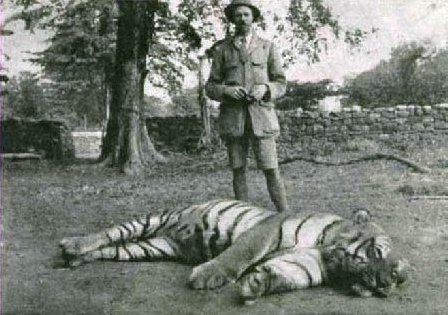Generally considered the most prolific individual man-eater in recorded history, a Bengal tigress was responsible for an estimated 436 deaths in Nepal and India. After avoiding the efforts of professional hunters and a massive operation by the Nepalese Army, the tigress was eventually tracked and killed by the renowned hunter Jim Corbett.
Historically, tigers have been responsible for more human fatalities than any other big cat. During the late 19th and early 20th century period that the Champawat tiger was active, the species was responsible for over 1,000 deaths annually across India. Over a five year period during the 1930s, tigers were responsible for over 7,000 deaths in India. Unlike the subcontinent’s other potential man-eater, the leopard, tigers rarely enter human settlements when hunting, and the majority of victims are those that are hunted and killed on the tiger’s own territory. This was the case with over 400 people killed and devoured by the Champawat tiger, which writer Dane Huckelbridge described as ‘the most prolific serial killer of human life the world has ever seen’ in his 2019 book No Beast So Fierce.
Researchers are unsure when the tiger’s killing spree began, but are confident that she began taking human prey in Nepal in the late 1890s. She quickly proved to be a prolific man-eater and by 1903 had killed at least 200 people. Her primary victims were the Tharu people, a group that lived in the foothills of the Himalayan mountains. Driven to desperation, the Nepalese Army launched a massive operation to catch and kill her. Despite dozens of soldiers taking part in the organised hunt they failed to kill the tiger, but a massive beating line successfully drove her over the border into India. She immediately resumed her killing spree, ultimately clocking up a further 234 recorded victims. Despite a significant reward offered by the British government that attracted professional hunters to the area, the rampage continued. Eventually, in desperation, the authorities contacted famed hunter Jim Corbett in 1907. Corbett already had a burgeoning reputation as a consummate hunter of tigers, and his successful hunt of the Champawat tiger would be the start of a vaunted career that would establish him as the world’s foremost hunter of man-eaters.

Corbett accepted the request for help, on the grounds that the monetary reward for killing the tiger was withdrawn, as were the shikari, professional Indian big game hunters. An Indian-born British hunter and tracker, Corbett took pride in his status as a sport hunter and was unwilling to associate himself with hunting an animal for financial gain. Insisting that other hunters were pulled out of the area, Corbett believed that they were likely to disrupt his own hunt or, worse, accidentally shoot him. The authorities readily agreed and Corbett traveled to Kumaon province. The tiger had most recently struck near the village of Champawat and so Corbett set out there first. He soon found that that the residents had spent the last five days in abject terror, having boarded themselves inside their huts.
Shortly after his arrival the tiger attacked and killed a teenage girl, dragging her off into the jungle. Corbett found a pronounced track left by the tiger hauling its victim, including deep pools of arterial blood and trails from her feet being dragged. Following the trail, Corbett initially failed to locate the tigress. He returned the following morning having arranging a beating line of over 300 villagers, who screamed, shouted and fired guns into the air as they progressed in formation along the gorge where the trail had led. Once the tiger broke cover Corbett eventually killed her after shooting her twice with a powerful hunting rifle, finishing her with a shotgun he was forced to snatch from a nearby villager. She was later found to have broken teeth, leading Corbett to believe that the tigress had resorted to hunting humans after her injuries had prevented her hunting her natural prey effectively.

Corbett would go on to track and kill a number of other Indian man-eaters, including several tigers and at least two leopards. However, after his final hunt in 1930, he renounced hunting and instead became a devoted conservationist and photographer. Using the skills he had developed tracking tigers with a rifle, he instead took to recording footage of them on a cine film camera. He was instrumental in the setting up of India’s first national park in the Kumaon Hills, close to where he had hunted the Champawat tiger many years before. In 1957, the park was renamed the Jim Corbett National Park in his memory after his death in 1955 at the age of 79.
This article was written to mark Endangered Species Day on 17th May 2019. Bengal tigers are listed as endangered on the IUCN Red List, with less than 2,500 individuals remaining. Sadly, poaching remains one of the most significant threats they face. Find out more about the efforts being made to safeguard the species and how you can help here https://www.worldwildlife.org/species/bengal-tiger
Feature Image: Malone Levanger

2 Comments